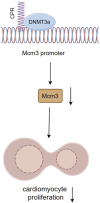A review on regulation of DNA methylation during post-myocardial infarction
- PMID: 38414735
- PMCID: PMC10896928
- DOI: 10.3389/fphar.2024.1267585
A review on regulation of DNA methylation during post-myocardial infarction
Abstract
Myocardial infarction (MI) imposes a huge medical and economic burden on society, and cardiac repair after MI involves a complex series of processes. Understanding the key mechanisms (such as apoptosis, autophagy, inflammation, and fibrosis) will facilitate further drug development and patient treatment. Presently, a substantial body of evidence suggests that the regulation of epigenetic processes contributes to cardiac repair following MI, with DNA methylation being among the notable epigenetic factors involved. This article will review the research on the mechanism of DNA methylation regulation after MI to provide some insights for future research and development of related drugs.
Keywords: DNA methylation; autophagy; fibrosis; inflammation; myocardial infarction; proliferation.
Copyright © 2024 Han, Wang, Wang, Maduray, Hao and Zhong.
Conflict of interest statement
The authors declare that the research was conducted in the absence of any commercial or financial relationships that could be construed as a potential conflict of interest.
Figures





Similar articles
-
The effector cells and cellular mediators of immune system involved in cardiac inflammation and fibrosis after myocardial infarction.J Cell Physiol. 2020 Dec;235(12):8996-9004. doi: 10.1002/jcp.29732. Epub 2020 Apr 30. J Cell Physiol. 2020. PMID: 32352172 Review.
-
Analysis of Time Series Gene Expression and DNA Methylation Reveals the Molecular Features of Myocardial Infarction Progression.Front Cardiovasc Med. 2022 Jun 24;9:912454. doi: 10.3389/fcvm.2022.912454. eCollection 2022. Front Cardiovasc Med. 2022. PMID: 35811717 Free PMC article.
-
The role and mechanism of hyperoside against myocardial infarction in mice by regulating autophagy via NLRP1 inflammation pathway.J Ethnopharmacol. 2021 Aug 10;276:114187. doi: 10.1016/j.jep.2021.114187. Epub 2021 May 4. J Ethnopharmacol. 2021. PMID: 33957207
-
Toll-like receptor 4 contributes to a myofibroblast phenotype in cardiac fibroblasts and is associated with autophagy after myocardial infarction in a mouse model.Atherosclerosis. 2018 Dec;279:23-31. doi: 10.1016/j.atherosclerosis.2018.10.018. Epub 2018 Oct 19. Atherosclerosis. 2018. PMID: 30399463
-
The Role of the Notch Signaling Pathway in Recovery of Cardiac Function after Myocardial Infarction.Int J Mol Sci. 2022 Oct 19;23(20):12509. doi: 10.3390/ijms232012509. Int J Mol Sci. 2022. PMID: 36293363 Free PMC article. Review.
Cited by
-
Fibroblast Diversity and Epigenetic Regulation in Cardiac Fibrosis.Int J Mol Sci. 2024 May 30;25(11):6004. doi: 10.3390/ijms25116004. Int J Mol Sci. 2024. PMID: 38892192 Free PMC article. Review.
-
The Influence of Metabolic Risk Factors on the Inflammatory Response Triggered by Myocardial Infarction: Bridging Pathophysiology to Treatment.Cells. 2024 Jun 29;13(13):1125. doi: 10.3390/cells13131125. Cells. 2024. PMID: 38994977 Free PMC article. Review.
References
-
- Bajpai G., Bredemeyer A., Li W., Zaitsev K., Koenig A. L., Lokshina I., et al. (2019). Tissue resident CCR2-and CCR2+ cardiac macrophages differentially orchestrate monocyte recruitment and fate specification following myocardial injury. Circulation Res. 124 (2), 263–278. 10.1161/CIRCRESAHA.118.314028 - DOI - PMC - PubMed
-
- Balasubramanian A., Kawahara G., Gupta V. A., Rozkalne A., Beauvais A., Kunkel L. M., et al. (2014). Fam65b is important for formation of the HDAC6-dysferlin protein complex during myogenic cell differentiation. FASEB J. official Publ. Fed. Am. Soc. Exp. Biol. 28 (7), 2955–2969. 10.1096/fj.13-246470 - DOI - PMC - PubMed
Publication types
LinkOut - more resources
Full Text Sources

